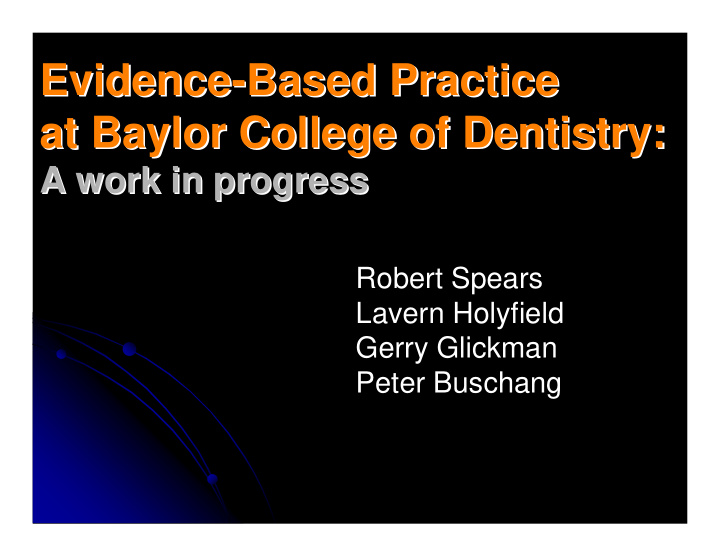



Evidence- -Based Practice Based Practice Evidence at Baylor College of Dentistry: at Baylor College of Dentistry: A work in progress A work in progress Robert Spears Lavern Holyfield Gerry Glickman Peter Buschang
Specific Aim s Specific Aim s Aim 1 : To provide instruction and experiences throughout the DDS curriculum to train students in the principles and skills of scientific inquiry and clinical research. Aim 2 : Provide additional instruction and experiences for a select group of dental students w ho w ish to engage in clinical or translational dental research as part of their dental academ ic research careers. Aim 3 : Enhance the educational skills of all BCD faculty for teaching students the scientific rationale for the incorporation of new inform ation and technologies into oral healthcare.
CUSPID*: A Curriculum To CUSPID*: A Curriculum To Create Science- -Oriented Oriented Create Science Dentists and Future Dentists and Future Academicians Academicians QuickTime™ and a decompressor are needed to see this picture. *Clinicians Using Science Produce Inspired Dentists
Figure 2
D1 Course: Principles of Principles of D1 Course: Evidence Based Dentistry Evidence Based Dentistry and Clinical Research and Clinical Research • Fall semester � tools to compare groups of people/ how to assess variation � types of research designs (descriptive, observational, experimental) � sampling & bias • Spring semester � detecting disease � how to review a paper � how to ask an evidence-based question � searching methods � Critically-Appraised Topics (CATS)
D1 Course: Principles of Principles of D1 Course: Evidence Based Dentistry Evidence Based Dentistry and Clinical Research and Clinical Research Mode of instruction is � heavily Blackboard-intensive with ‘homework’ questions � lecture-based, but highly interactive � frequent use of ‘clickers’ to gauge student understanding of homework and ongoing lecture
D1 Course: Principles of Principles of D1 Course: Evidence Based Dentistry Evidence Based Dentistry and Clinical Research and Clinical Research Small group sessions � “ Lab ” in which to practice the skills they are learning � Around 16 students per group � Discuss a paper on a clinically-relevant topic using a standardized format � Topics: breastfeeding & caries; fluoride in water & hip fracture; tobacco use & tooth loss; fluoride varnish & caries prevention
Goals for Faculty Development Goals for Faculty Development Increase visibility of EBD Increase visibility of EBD ‘culture culture’ ’ for all full for all full- -time faculty time faculty ‘ EBD training for interested EBD training for interested clinical faculty clinical faculty Cultivate EBD Cultivate EBD leaders leaders
EBD Training for Clinical Faculty EBD Training for Clinical Faculty � Audit the D1 course Audit the D1 course Intro to EBD Intro to EBD � � Small group instruction by EBD Small group instruction by EBD ‘ ‘expert expert’ ’ � � Other ?????? Other ?????? � Following this training, clinical faculty could: Following this training, clinical faculty could: � Participate in/ lead a small group session Participate in/ lead a small group session � � Introduce EBD content into their course Introduce EBD content into their course � (e.g., CATs) (e.g., CATs)
The Dental Scholars Program The Dental Scholars Program � Premise Premise � � Nourish and energize a subset of dental Nourish and energize a subset of dental � students with a strong interest in clinical students with a strong interest in clinical research and a career in dental academics research and a career in dental academics � Activities Activities � � Engagement in a spectrum of roles played by Engagement in a spectrum of roles played by � clinician- -scientists in an academic setting scientists in an academic setting clinician � Researcher Researcher � � Mentor Mentor � � Teacher Teacher �
Assess… … Assess Assess… … Assess! Assess! Assess • Survey to be administered this semester to all FT faculty and D1 & D2 students • Baseline against which changes in ‘EBD culture’ can be evaluated • Questions regarding: � Practices (sources of evidence) � Experience (formal training in research methodology, participation in research) � Attitudes (beliefs about EBD) � Knowledge (questions derived from structured abstract of clinically-relevant research)
Recommend
More recommend